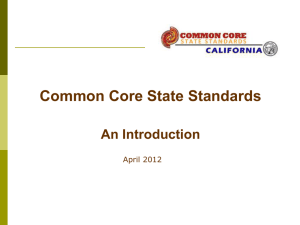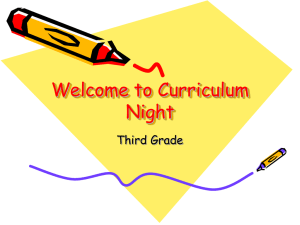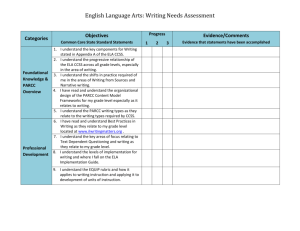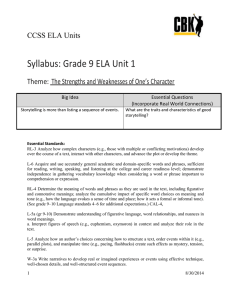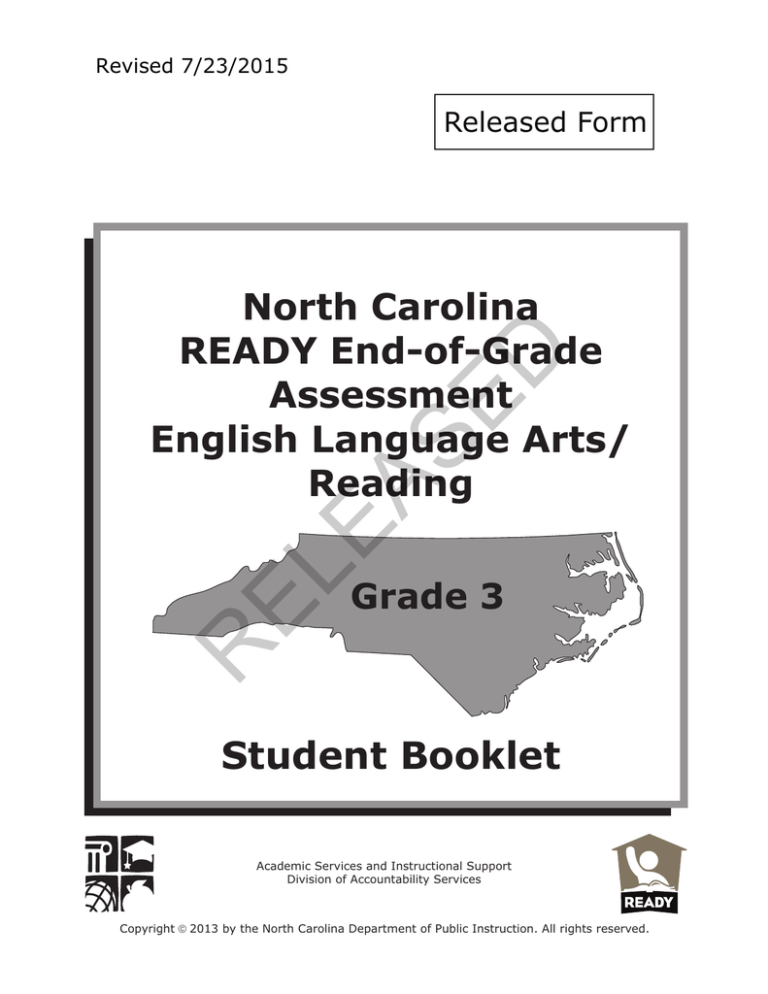
Revised 7/23/2015
Released Form
EL
EA
SE
D
North Carolina
READY End-of-Grade
Assessment
English Language Arts/
Reading
R
Grade 3
Student Booklet
Academic Services and Instructional Support
Division of Accountability Services
Copyright ã 2013 by the North Carolina Department of Public Instruction. All rights reserved.
GRADE 3 ENGLISH LANGUAGE ARTS/READING—RELEASED FORM
Sample Questions
The Rhinoceros
by Oliver Herford
S2
A
calm
B
eager
C
scared
D
upset
EL
How does the Rhinoceros look at the beginning of the poem?
R
S1
Well, since he cares so much for style,
Let’s give him two and see him smile.
EA
10
SE
D
So this is the Rhinoceros!
I wonder why he looks so cross.
Perhaps he is annoyed a bit
Because his clothing does not fit.
5 (They say he got it ready made!)
It is not that, I am afraid.
He looks so cross because I drew
Him with one horn instead of two.
What would change the Rhinoceros’s feelings?
A
giving him new clothing
B
being afraid of his size
C
drawing him with two horns
D
showing off his new style
1
GRADE 3 ENGLISH LANGUAGE ARTS/READING—RELEASED FORM
Claudia’s Collection
by Andrea Fitcha
“FREEZE! DON’T MOVE,” said Claudia. Her friend Marcus stood perfectly still as Claudia
knelt down on the sidewalk in front of him. “What’s the matter?” he asked. “I don’t have
a bug on me, do I?”
“No,” said Claudia. “I found a feather. I didn’t want you to step on it.”
D
“A feather?” said Marcus. “Big deal. Come on, we’re going to be late for school.”
EA
SE
4
It was a big deal to Claudia. She was a collector. When she was four years old, her
grandpa had given her a tackle box full of fishing lures.* She loved sorting all the lures
by color and shape and putting them into separate compartments. After that, she
started collecting all kinds of things. Her room was filled with interesting objects she
picked up during the day: rocks, coins, string, even paper clips. She had shells from
trips to the beach, leaves and pine cones from the trees in her neighborhood, and
leftover beads from her mother’s craft projects. Everything she found she put into
labeled shoeboxes.
EL
“What are you bringing for Hobby Week?” asked Marcus.
“I don’t know,” said Claudia, as she picked up a brightly colored rock.
R
7
“What do you mean, you don’t know?” said Marcus. “Bring one of your collections.
You’ve got a million of them!”
Claudia sighed. She wanted to bring one of her collections, but she couldn’t decide which
one. The night before, she’d gone through all of her boxes twice. She wanted to bring
something really special for Hobby Week.
When they got to school, Mrs. Wilson said, “O.K., who has a hobby to share?”
Claudia kept her hand down. She watched as Katie brought a big box up to the front of
the classroom. “This is my money collection,” said Katie. “My dad travels all around the
*
lures: used to attract fish
2
Go to the next page.
GRADE 3 ENGLISH LANGUAGE ARTS/READING—RELEASED FORM
world for his job, and he brings me money from the different countries he goes to.” She
opened the box and took out the coins and paper money. There was money from
Canada, Japan, and even Australia! The class looked at all the pictures on the coins.
They were surprised that paper money came in so many different colors.
Claudia frowned. She really wanted to be in front of the class, sharing her hobby. But
which collection should she bring?
D
The next day, before school, Claudia looked over her shoeboxes again. Claudia’s mother
poked her head in the doorway and looked at the rows and rows of shoeboxes that lined
Claudia’s room. “If this keeps up, we’re going to have to move your bed out into the
hall,” she said smiling.
SE
“I have plenty of room,” Claudia said. “I can stack them all the way to the ceiling if I
have to.” She noticed she was running late, so she just decided to bring her biggest
collection: her rock collection.
EA
At show-and-tell time Claudia raised her hand, but Mrs. Wilson called on Joseph first. He
brought a giant wooden case to the front of the class and opened it up. Claudia groaned.
It was the biggest rock collection she’d ever seen! The class oohed and aahed at all the
pretty and unusual rocks.
EL
Claudia did not raise her hand again. She hid her shoebox in her backpack until school
was over.
R
The next day, Claudia brought her prettiest collection: her seashells. At show-and-tell
time she raised her hand in the air and waved it around, but Mrs. Wilson called on
Annie. Claudia watched as she brought up a big piece of poster board. Annie had glued
different shells to it and labeled each one. Claudia slid down in her seat and shoved her
box of shells under her desk.
The night before the last day of Hobby Week, Claudia emptied her pockets and looked at
all of the things she had collected that day. She began to sort everything into several
different piles. Suddenly, she had an idea. She went into the garage to find her old
wagon.
The next day, Marcus brought his telescope and his book about the planets. Then
Marissa showed the class all the different tricks she could do with her jump rope.
“Does anyone else have something to share?” asked Mrs. Wilson.
Claudia raised her hand. “Go ahead, Claudia,” said Mrs. Wilson.
3
Go to the next page.
GRADE 3 ENGLISH LANGUAGE ARTS/READING—RELEASED FORM
Claudia wheeled her wagon to the front of the class. She brought out all of her
shoeboxes and laid them on the table. The class murmured. There were so many boxes
they barely fit on the table! Claudia opened each box. Everyone stared at the rocks,
seashells, leaves, rubber bands, fishing lures, feathers, and beads.
“Wow! Look at all that stuff!” said Joseph.
“I don’t get it,” said Annie. “What’s your hobby?”
“I collect collections,” said Claudia proudly.
D
Everyone laughed.
2
daring
B
frustrated
C
honest
D
organized
EL
A
EA
Which word describes Claudia?
R
1
SE
“Well,” said Mrs. Wilson. “This is definitely the best—and the first—collection of
collections I’ve ever seen!”
Why did Claudia not show her rock and shell collections to the class?
A
Claudia wanted to show a collection the class had never seen.
B
Claudia was too shy to talk in class.
C
Mrs. Wilson would not let her go first.
D
Mrs. Wilson did not want to see two collections that were alike.
4
Go to the next page.
GRADE 3 ENGLISH LANGUAGE ARTS/READING—RELEASED FORM
A
coins
B
lures
C
activities
D
surprises
D
In paragraph 7, what does Marcus mean when he says to Claudia, “Bring one of
your collections. You’ve got a million of them!”?
Claudia should share all of her collections with the class.
B
Claudia should be concerned since she has no hobby.
C
Claudia has several collections from which to choose.
D
Claudia would have to borrow a collection from a friend.
EA
SE
A
EL
4
What is the meaning of the word projects as used in paragraph 4?
R
3
5
Go to the next page.
GRADE 3 ENGLISH LANGUAGE ARTS/READING—RELEASED FORM
5
Which word completes the graphic organizer?
fishing
lures
rocks
Claudia’s
Collection
seashells
feathers
C
jump ropes
D
wagon
SE
B
EA
telescope
EL
What do Claudia and Annie have in common?
A
Both collect coins.
B
Both collect feathers.
C
Both collect rocks.
D
Both collect seashells.
R
6
A
D
?
6
Go to the next page.
GRADE 3 ENGLISH LANGUAGE ARTS/READING—RELEASED FORM
At the end of the story, what was Mrs. Wilson’s reaction to Claudia’s hobby?
She thought it was the best collection of collections.
B
She thought it was the biggest rock collection of all.
C
She was surprised paper money came in many colors.
D
She was surprised that the seashells were so different.
EL
EA
SE
D
A
R
7
7
Go to the next page.
GRADE 3 ENGLISH LANGUAGE ARTS/READING—RELEASED FORM
Camels
by Elaine Landau
If you were asked to name a desert animal, would you say the camel? Camels are
mentioned in many songs, stories, and films about deserts. A camel’s most unusual
feature is the hump on its back. The hump is actually a lump of fat that provides the
camel with energy when food is scarce.
SE
D
There are two types of camels—the Arabian, or one-humped camel, and the Bactrian, or
two-humped camel. Both are well suited to the desert. The camel has long, thick
eyelashes that stop wind-blown sand from getting in its eyes. And its nostrils close tight
to keep out sand. The camel’s bushy eyebrows are also useful. They shade its eyes from
the sun.
EA
3
Camels can go without water for weeks, especially if they can feed on dew-dampened
plants or desert fruits. A camel can lose one-fourth of its body weight in water without
any distress.
EL
4
Camels do not store water in their humps, but their bodies conserve water in other
ways. Unlike humans, camels do not sweat much. Instead, their body temperature tends
to rise slowly during the day and drop at night.
*
R
There are no longer any one-humped camels in the wild—all are domesticated.*
However, some small herds of two-humped camels still roam free. Today, these animals
are in danger of dying out, so they are protected by law.
domesticated: tame
8
Go to the next page.
GRADE 3 ENGLISH LANGUAGE ARTS/READING—RELEASED FORM
There are songs and films about camels.
B
There are two types of camels in the world.
C
A camel’s most unusual feature is its hump.
D
A camel adapts well to life in the desert.
thick eyelashes
B
closed nostrils
C
humped backs
D
bushy eyebrows
SE
A
D
According to the text, what is the camel’s strangest feature?
EA
10
A
What is the purpose of a camel’s hump?
A
to keep it from sweating
B
to store water for many weeks
C
to provide energy when there is no food
D
to help its body temperature stay low
EL
9
What is the main idea of the selection?
R
8
9
Go to the next page.
GRADE 3 ENGLISH LANGUAGE ARTS/READING—RELEASED FORM
They have long, thick eyelashes.
B
They enjoy hot, dry weather.
C
They sweat similar to humans.
D
They feed on dew-dampened plants.
to help it see the desert better
B
to help shade its eyes from the sun
C
to protect its breathing ability
D
to keep sweat out of its eyes
SE
A
D
According to the selection, why are the camel’s bushy eyebrows important?
EA
13
A
In paragraph 3, how would “dew-dampened” plants help the camels go for weeks
without water?
EL
12
According to the selection, why are camels well-suited for sandstorms?
A
“Dew-dampened” plants provide shade for camels.
B
“Dew-dampened” plants provide a source of water for camels.
C
“Dew-dampened” plants help the camels store fat in their humps.
D
“Dew-dampened” plants help the camels lose weight.
R
11
10
Go to the next page.
GRADE 3 ENGLISH LANGUAGE ARTS/READING—RELEASED FORM
sadness
B
suffering
C
fear
D
sleep
D
What is the similarity between paragraphs 3 and 4?
They both describe how camels look.
B
They both describe where camels live.
C
They both explain why camels are well-suited for running.
D
They both explain why camels can go without water for long periods.
SE
A
EA
16
A
In paragraph 4, what does the word conserve mean?
A
build
B
form
C
help
D
save
EL
15
In paragraph 3, what is the meaning of the word distress?
R
14
11
Go to the next page.
GRADE 3 ENGLISH LANGUAGE ARTS/READING—RELEASED FORM
Freddie
by Phil Bolsta
I don’t like doing homework,
I know that it will bore me.
But now I am much happier
‘Cause Freddie does it for me!
He greets me at the door each day
When I come home from school.
He just can’t wait to read my books—
I think that’s pretty cool!
SE
D
5
My grades are so much better now,
Which makes my parents glad.
Freddie is the smartest dog
That I have ever had!
17
R
EL
15
I give him all my homework,
Like history and math.
And when he’s done I give him
A nice warm bubble bath!
EA
10
According to the poem, what makes the speaker happy?
A
playing outside
B
taking a bubble bath
C
not going to school
D
not doing homework
12
Go to the next page.
GRADE 3 ENGLISH LANGUAGE ARTS/READING—RELEASED FORM
calm
B
tire
C
excite
D
help
barks
B
catches
C
welcomes
D
surprises
SE
A
D
In line 5, what does the word greets mean?
EA
20
A
What is the meaning of line 8?
A
The speaker loves that Freddie can read.
B
The poem is about doing homework.
C
The speaker likes being at home.
D
The poem takes place during winter.
EL
19
What is the meaning of bore in line 2?
R
18
13
Go to the next page.
GRADE 3 ENGLISH LANGUAGE ARTS/READING—RELEASED FORM
A
They like having a pet.
B
Their child’s grades have improved.
C
They taught Freddie a new trick.
D
Their child now does his own homework.
“I don’t like doing homework,”
B
“I know that it will bore me.”
C
“I think that’s pretty cool!”
D
“Like history and math.”
EA
SE
A
D
Which phrase supports the happy feeling of the poem?
EL
22
Based on the poem, why are the speaker’s parents happy?
R
21
14
Go to the next page.
GRADE 3 ENGLISH LANGUAGE ARTS/READING—RELEASED FORM
Masters of Verse
by Kassandra Radomski
Dr. Seuss and Shel Silverstein—two famous authors—were experts at writing silly,
rhyming poems that make kids giggle. Both caught the writing “bug” at an early age,
and it went hand-in-hand with their talent for drawing kooky characters. But it was their
friends who helped and encouraged them to write for children.
D
Dr. Seuss, born Theodore Seuss Geisel, credits his mother for his ability to write with
rhythm. When he was little, she would lull him to sleep with chants she learned from
selling pies in her father’s bakery.
EL
EA
SE
3
Dr. Seuss grew up to be a successful illustrator and cartoonist. But it was a rhythm he
heard in 1937 that gave him the idea for his first children’s book. Dr. Seuss and his wife
were on a ship headed to Europe when a storm broke out. Dr. Seuss noticed the rhythm
of the choppy waters against the boat. He began to think of words to go along with it.
Days later he started a story with those words. When he was done writing it, he tried to
find someone to publish it. But 27 publishers refused—the book was just too unusual.
When he was about to give up, Dr. Seuss ran into a friend who agreed to publish it. That
book is now called And to Think That I Saw It on Mulberry Street. It has sold millions of
copies around the world! Dr. Seuss went on to publish more than 60 children’s books.
R
4
Dr. Seuss was fascinated with rhymes and invented words. But he also thought rhymes
helped kids pronounce words correctly. He liked writing books that encouraged kids to
read, too. In The Cat in the Hat, he used about 220 words to create a book simple
enough for beginning readers, but it became popular with everyone.
Around the time Dr. Seuss’s first book was published, Shel Silverstein was just a young
boy. He taught himself to draw when he was five by tracing over the comics in the
newspaper. Then he began drawing his own cartoons, and making up stories to go along
with them.
When Shel got older, he was still creating cartoons, but these were for adults. He was
also a folk singer and songwriter. Shel’s musical experience likely influenced the rhythm
of his poetry. But he didn’t begin writing for children until a friend convinced him he
could do it.
15
Go to the next page.
GRADE 3 ENGLISH LANGUAGE ARTS/READING—RELEASED FORM
Shel wrote three books for kids before his book of poetry, Where the Sidewalk Ends, was
published in 1974. It had taken him nearly 10 years to finish!
When Shel wrote poetry, he liked the words to be unplanned—to just spill out from his
thoughts to the paper. He didn’t like to change the words or phrases in a poem once he
had written them. If someone suggested part of a poem didn’t sound right, he would
come up with an entirely new version of it.
9
D
When Where the Sidewalk Ends came out, many thought the silly rhymes in it were like
Dr. Seuss’s. Yet parents feared that some of the poems would cause kids to disobey
their parents and teachers. Many school libraries banned it. Eventually, though, Where
the Sidewalk Ends became one of Shel’s best-selling children’s books.
Which statement summarizes the selection?
Two men with different backgrounds became famous writers of children’s
books.
B
Two men met and decided to write a series of children’s books as partners.
C
Two men became famous poets after discovering that they both liked the
same subjects.
D
Two men wrote books on the same topic after meeting in school and
becoming friends.
EL
A
R
23
EA
SE
Writing and publishing their work didn’t always come easily. But both Shel Silverstein’s
and Dr. Seuss’s use of rhythm, rhyme, and silly-sounding words show us poetry can be
fun.
16
Go to the next page.
GRADE 3 ENGLISH LANGUAGE ARTS/READING—RELEASED FORM
to look for different types of insects
B
to choose to draw unusual insects
C
to want to write, more than anything else
D
to become ill from writing too much
D
Based on paragraphs 3 and 9, how are Shel Silverstein and Dr. Seuss similar?
Both were born in the same year.
B
Both had difficulties with their first books.
C
Both were singers and writers for the U.S. Army.
D
Both had mothers who were writers.
SE
A
EA
26
A
In paragraph 4, what does the word pronounce mean?
A
to say
B
to define
C
to learn to spell
D
to learn to write
EL
25
What does it mean to catch “the writing bug”?
R
24
17
Go to the next page.
GRADE 3 ENGLISH LANGUAGE ARTS/READING—RELEASED FORM
He began writing songs instead.
B
He became upset with the person.
C
He only rewrote the necessary words.
D
He rewrote the entire poem.
D
According to the text, why did many school libraries ban Shel Silverstein’s book
Where the Sidewalk Ends?
Parents thought the poems would cause children to disobey them.
B
Parents thought the poems would cause children to make up stories.
C
Parents thought the poems were too goofy for their children.
D
Parents thought the poems were too long for their children.
SE
A
EA
29
A
Which sentence from the selection supports the idea that writing can be hard
work?
EL
28
How did Shel Silverstein react to someone saying he needed to edit a poem?
A
“He was also a folk singer and songwriter.”
B
“It had taken him nearly 10 years to finish!”
C
“He didn’t like to change the words or phrases in a poem once he had
written them.”
D
“When Where the Sidewalk Ends came out, many thought the silly rhymes in
it were like Dr. Seuss’s.”
R
27
18
Go to the next page.
GRADE 3 ENGLISH LANGUAGE ARTS/READING—RELEASED FORM
The Sticky-Sticky Pine
by Florence Sakade
D
Once there was a woodcutter. He was very poor but very kind. Never would he tear off
the living branches of a tree to make firewood. Instead, he would gather only the dead
branches on the ground. He knew what happened when you tore a branch off a tree.
The sap, which is the blood of a tree, would drip and drip, just as though the poor tree
were bleeding. So, since he didn’t want to harm the trees, he never tore off the
branches.
“Sticky, sticky is my sap,
For my tender twigs are snapped.”
SE
One day he was walking beneath a high pine tree hunting for firewood when he heard a
voice, saying:
EA
The woodcutter looked and, sure enough, someone had broken three limbs off the pine
and the sap was running out. Skillfully, he mended them, saying:
EL
“Now these tender twigs I’ll wrap,
And in that way stop the sap.”
And he tore a piece from his own clothes to make a bandage.
R
No sooner had he finished than many tiny gold and silver things fell from the tree. It
was money—a lot of it. The surprised woodcutter was almost covered up with it. He
looked at the tree and smiled and thanked it. Then he took the money home.
8
There was a great amount, and he slowly realized that he was now a very rich
woodcutter indeed. Everyone knows that the pine tree is the sign of prosperity in Japan
and, sure enough, the grateful pine had made him very rich.
Just then a face appeared in the window. It was the face of another woodcutter. But this
woodcutter was neither nice nor kind. In fact, it was he who had torn off the branches of
the pine and had broken its twigs. When he saw the money, he said: “Where did you get
all that money? Look how nice and bright it is.”
The good woodcutter held up the money so the other could see. It was oblong in shape,
the way money used to be in Japan, and he had five basketfuls. He told the bad
19
Go to the next page.
GRADE 3 ENGLISH LANGUAGE ARTS/READING—RELEASED FORM
woodcutter how he had gotten the money.
“From that big pine tree?”
“Yes, that was the one.”
“Hmm,” said the bad woodcutter and ran away as fast as he could go. He ran right up to
the old pine tree, and the tree said:
“Sticky, sticky is my blood.
Touch me, you’ll receive a flood.”
SE
D
“Oh, just what I want,” said the bad man, “a flood of gold and silver.” He reached up
and broke off another branch. The pine tree suddenly showered him, but it showered
him with sticky, sticky sap—not gold and silver at all.
EA
The bad woodcutter was covered with sap. It got in his hair and on his arms and legs.
Since it was so sticky, he couldn’t move and though he called for help, no one could hear
him. He had to remain there for three days—one day for each branch—until the sap
became soft enough for him to drag himself home.
What shows that the poor woodcutter is kind?
A
He is happy about his new wealth.
B
He gathers only the dead tree branches.
C
He takes sap only from the broken limbs.
D
He shares his money with the bad woodcutter.
R
30
EL
And, after that, he never broke another branch off a living tree.
20
Go to the next page.
GRADE 3 ENGLISH LANGUAGE ARTS/READING—RELEASED FORM
31
In the section below, what is the meaning of mended?
“Skillfully, he mended them, saying: ‘Now these tender twigs I’ll wrap, / And in
that way stop the sap.’ ”
escaped
C
repaired
D
attacked
D
B
good fortune
B
bad luck
C
a winter holiday
D
a warm season
EA
A
SE
According to the text, what does a pine tree represent?
EL
33
earned
In paragraph 8, what is the meaning of grateful?
A
eager
B
careless
C
angry
D
thankful
R
32
A
21
Go to the next page.
GRADE 3 ENGLISH LANGUAGE ARTS/READING—RELEASED FORM
34
A
He breaks off living tree branches.
B
After seeing the money, he is angry.
C
He steals the nice woodcutter’s money.
D
After seeing the money, he runs to the pine tree.
In the sentence below, what was meant when the bad woodcutter said he wanted
“a flood of gold and silver”?
D
35
Which action shows that the bad woodcutter is greedy?
He wanted lots of money.
B
He wanted it to rain for days.
C
He wished for fine clothing.
D
He wished for a new house.
EL
EA
A
According to the selection, what did the tree do to the bad woodcutter?
A
The tree flooded him with sap.
B
The tree showered him with coins.
C
The tree fell over on him.
D
The tree dropped its leaves on him.
R
36
SE
“Oh, just what I want,” said the bad man, “a flood of gold and silver.”
22
Go to the next page.
GRADE 3 ENGLISH LANGUAGE ARTS/READING—RELEASED FORM
Echoes . . . Echoes . . . Echoes . . . Echoes
SE
Hello!
D
Have you ever heard echoes? You might hear them when you are in the mountains or a
cave. You shout “hello,” and from somewhere, you hear “hello” back. It’s rather spooky
the first time you hear your echo. An echo is your own voice answering you!
EL
EA
Hello!
R
You don’t have to go to the mountains or caves to hear your echo. You can hear your
echo in your backyard no matter where you live.
What You Need:
•
•
a garden hose 50 feet long or longer
your voice and your ear
What You Do
3
The garden hose MUST be EMPTY with no water in it. Ask an adult to empty the hose for
you if it contains water. Bring the two ends of the hose together. Hold one end up to
your mouth and the other end up to your ear. If there is a lot of noise around, ask a
friend to cover your other ear.
23
Go to the next page.
GRADE 3 ENGLISH LANGUAGE ARTS/READING—RELEASED FORM
Shout “hello” into the hose. You will hear an echo “hello” from the end of the hose at
your ear. Shout again and your echo will repeat what you shout.
The Science Secret
Sound travels through the air. It travels very fast, but it does take time. If a friend
stands far away from you and claps his hands together, you will see him clap before you
hear him clap. The sound of his clap takes time to travel to your ear. This is what causes
an echo. You hear yourself shout “hello” when you first shout it, but your “hello” also
travels through the air inside the hose, and after it travels all the way through the hose,
it returns to your ear and you hear it again.
SE
D
That’s the way mountain echoes work too. Your “hello” travels through the air until it
hits a mountainside. Then it bounces back, and you hear it again. Of course, it traveled
a long way before you heard it again, so it sounds like “someone else.”
R
EL
!
O
LL
HE
HELLO!
EA
Your echo in the hose will be better if your “hello” has to travel farther before coming
back to your ear, too. If you have a 100 foot garden hose, try that!
24
Go to the next page.
GRADE 3 ENGLISH LANGUAGE ARTS/READING—RELEASED FORM
scary
B
exciting
C
interesting
D
disappointing
D
Based on the text and the first illustration, what is an echo?
another person answering a person who yells
B
a person’s own voice answering back
C
an experiment using a garden hose
D
a fun game to play with friends
SE
A
EA
39
A
In paragraph 3, what is the meaning of contains?
A
wipes
B
leaks
C
holds
D
sprays
EL
38
In the first paragraph, what is the meaning of spooky?
R
37
25
Go to the next page.
GRADE 3 ENGLISH LANGUAGE ARTS/READING—RELEASED FORM
Empty the water out of the hose.
B
Find a garden hose 50 feet long or longer.
C
Ask an adult to help with the experiment.
D
Hold one end of the hose up to the mouth.
D
According to the text and the picture, what happens when “hello” is shouted into
the hose?
An echo “hello” travels through the water and into the ear.
B
An echo “hello” travels through and down the mountain.
C
An echo “hello” will be heard from the end of the hose at the ear.
D
An echo “hello” will be heard in the next door neighbor’s backyard.
SE
A
EA
42
A
What is the main purpose of “The Science Secret” section?
EL
41
In the experiment, what step follows “Bring the two ends of the hose together”?
A
to tell a story about echoes
B
to explain how to create an echo
C
to describe why echoes are heard
D
to persuade the reader to create an echo
R
40
26
Go to the next page.
GRADE 3 ENGLISH LANGUAGE ARTS/READING—RELEASED FORM
A
through time
B
through a cave
C
through water
D
through the air
D
According to the selection, why would an echo be better if a 100-foot garden hose
is used?
The sound would be louder.
B
The sound would travel farther.
C
The sound would go through more water.
D
The sound would go through a small opening.
EA
SE
A
EL
44
According to the selection, how does sound travel?
R
43
27
Go to the next page.
GRADE 3 ENGLISH LANGUAGE ARTS/READING—RELEASED FORM
This is the end of the English Language Arts/Reading test.
Directions:
1. Look back over your answers for the test questions.
2. Put all of your papers inside your test book and close your test book.
R
EL
EA
SE
D
3. Stay quietly in your seat until your teacher tells you that testing is
finished.
28
D
SE
ACKNOWLEDGMENTS
EA
The North Carolina Department of Public Instruction wishes to express gratitude to the following
authors and publishers, whose generous permission to reprint literary selections has made these
tests possible. Every effort has been made to locate the copyright owners of material reprinted in
this test booklet. Omissions brought to our attention will be corrected in subsequent editions.
R
EL
“Claudia’s Collection” by Andrea Fitcha, from Spider, May 2004, Vol. 11, No. 5, copyright © 2004
by Carus Publishing Company. Reproduced with permission. All Cricket Media material is
copyrighted by Carus Publishing Company, d/b/a Cricket Media, and/or various authors and
illustrators. Any commercial use or distribution of material without permission is strictly prohibited.
Please visit http://www.cricketmedia.com/info/licensing2 for licensing and http://cricketmedia.com
for subscriptions.
“Camels” from Desert Mammals by Elaine Landau, copyright © 1996 Children’s Press. All rights
reserved. Reprinted by permission of Children’s Press, an imprint of Scholastic Library Publishing
Inc.
“Freddie” by Phil Bolsta. Copyright © 1991 by Phil Bolsta. Reprinted with the permission of the
author. philbolsta.com
“Masters of Verse” by Kassandra Radomski from Appleseeds issue: Playing with Words: Poets and
Poetry, © 2010 Carus Publishing Company. Reproduced with permission. All Cricket Media material
is copyrighted by Carus Publishing Company, d/b/a Cricket Media, and/or various authors and
illustrators. Any commercial use or distribution of material without permission is strictly prohibited.
Please visit http://www.cricketmedia.com/info/licensing2 for licensing and http://cricketmedia.com
for subscriptions.
“The Sticky-Sticky Pine” from Japanese Children’s Favorite Stories edited by Florence Sakade.
Copyright © 1958 by Tuttle Publishing, Inc. Reprinted by permission of the publisher.
“Echoes . . . Echoes . . . Echoes . . . Echoes” from Boys’ Quest magazine, June/July 2008, Vol. 14.
Copyright © 2008. Reprinted by permission of Boys’ Quest magazine.
G R A D E 3 E N G L I S H L A N G U A G E A R T S / R E A D I N G — R E L E A SE D F O R M
Grade 3 English Language Arts/Reading
RELEASED Form
2012–2013
Answer Key
Type
Key
Standard
S1
MC
D
S2
MC
C
1
MC
D
CCSS.ELA.CONTENT.3.RL.3
2
MC
A
CCSS.ELA.CONTENT.3.RL.3
3
MC
C
CCSS.ELA.CONTENT.3.RL.4
4
MC
C
CCSS.ELA.CONTENT.3.RL.4
5
MC
B
CCSS.ELA.CONTENT.3.RL.1
6
MC
D
7
MC
A
8
MC
D
9
MC
10
MC
11
MC
SE
D
Item number
CCSS.ELA.CONTENT.3.RL.1
CCSS.ELA.CONTENT.3.RL.2
EA
CCSS.ELA.CONTENT.3.RI.2
CCSS.ELA.CONTENT.3.RI.1
C
CCSS.ELA.CONTENT.3.RI.1
A
CCSS.ELA.CONTENT.3.RI.3
MC
B
CCSS.ELA.CONTENT.3.RI.3
MC
B
CCSS.ELA.CONTENT.3.RI.4
MC
B
CCSS.ELA.CONTENT.3.L.4.a
MC
D
CCSS.ELA.CONTENT.3.RI.8
16
MC
D
CCSS.ELA.CONTENT.3.L.4.a
17
MC
D
CCSS.ELA.CONTENT.3.RI.1
18
MC
B
CCSS.ELA.CONTENT.3.RL.4
19
MC
C
CCSS.ELA.CONTENT.3.L.4.a
20
MC
A
CCSS.ELA.CONTENT.3.L.5.a
21
MC
B
CCSS.ELA.CONTENT.3.RL.3
22
MC
C
CCSS.ELA.CONTENT.3.RL.4
13
14
15
R
12
EL
C
G R A D E 3 E N G L I S H L A N G U A G E A R T S / R E A D I N G — R E L E A SE D F O R M
Type
Key
23
MC
A
CCSS.ELA.CONTENT.3.RI.2
24
MC
C
CCSS.ELA.CONTENT.3.L.5.a
25
MC
B
CCSS.ELA.CONTENT.3.RI.8
26
MC
A
CCSS.ELA.CONTENT.3.RI.4
27
MC
D
CCSS.ELA.CONTENT.3.RI.3
28
MC
A
CCSS.ELA.CONTENT.3.RI.1
29
MC
B
CCSS.ELA.CONTENT.3.RI.1
30
MC
B
CCSS.ELA.CONTENT.3.RL.3
31
MC
C
CCSS.ELA.CONTENT.3.RL.4
32
MC
A
CCSS.ELA.CONTENT.3.RL.4
33
MC
D
CCSS.ELA.CONTENT.3.L.4.a
34
MC
D
35
MC
A
36
MC
A
37
MC
38
MC
39
MC
42
43
44
SE
CCSS.ELA.CONTENT.3.RL.4
EA
CCSS.ELA.CONTENT.3.RL.1
CCSS.ELA.CONTENT.3.L.4.a
B
CCSS.ELA.CONTENT.3.RI.7
C
CCSS.ELA.CONTENT.3.L.4.a
MC
D
CCSS.ELA.CONTENT.3.RI.3
MC
C
CCSS.ELA.CONTENT.3.RI.7
MC
C
CCSS.ELA.CONTENT.3.RI.1
MC
D
CCSS.ELA.CONTENT.3.RI.1
MC
B
CCSS.ELA.CONTENT.3.RI.3
EL
41
CCSS.ELA.CONTENT.3.RL.3
A
R
40
Standard
D
Item number
Item Types:
MC = multiple choice
Note about selections:
Reading for literature texts can be stories or poems.
Reading for informational texts can be scientific, historical, economic, or technical.



